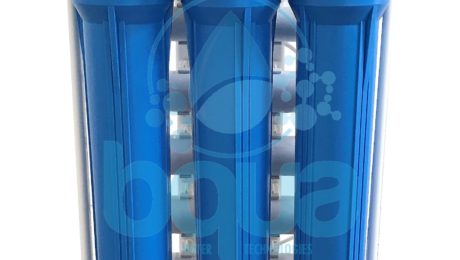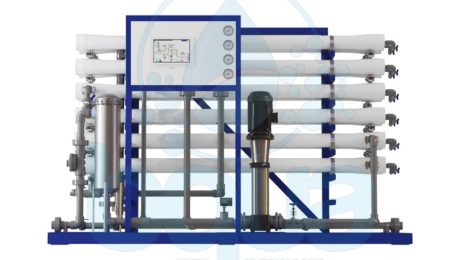What is a Reverse Osmosis System – RO System Definition
A Reverse Osmosis System is basically the application of the reverse of the Osmosis process. Where pure water is produced out of brackish or seawater by applying a pressure to the concentrated salt solution above the applied and osmotic back pressures. An Industrial Reverse Osmosis System works the same way as illustrated. Net driving pressure (NDP) forces water through the membrane. In an operating Reverse Osmosis system, feed water is pressurized by a high pressure pump. Due to Net Driving Pressure (NDP), a portion of the feed water is forced through the Reverse Osmosis semipermeable membrane.
The membrane is completely impermeable (won’t allow passage) to particles and only slightly permeable to dissolved substances. The water that passes through the membrane is called permeate. Permeate usually has very few particles in it. Unless there is a membrane defect (hole) or other problem, any particles found in the permeate were produced there (either from bacteria or equipment). Permeate is also low in dissolved substances (a small amount of dissolved solids does pass through the membrane). Permeate, therefore, is a relatively high purity water. Figure below illustrates a Reverse Osmosis System in the format we have been using so far.
Reverse Osmosis System (RO System) Illustration
Reverse Osmosis System Operation and Flushing
We know that when we pressurize the feed water and water passes through the membrane, the feed water is concentrated. If the concentration in the feed water gets high enough, the osmotic back pressure will rise to eventually give us a Net Driving Pressure (NDP) of zero and the flow will stop. In a Reverse Osmosis System, then, we must flush away the dissolved substances from the membrane surface so that the osmotic back pressure won’t keep going up. This is different from the other filters that we usually work with. Most of the filters that we have dealt with in our lives have been “full flowâ€, “accumulative†types of filters. “Full flow†means that there is one stream in (feed water) and one stream out (filtrate). “Accumulative†means that the filtered “stuff†accumulate in or on the filter.
From coffee filters, to cartridge filters, to multimedia filters, this has been the case. The feed water goes in, the filter removes the “stuff†that we want to take. When the filter gets full, we backwash or replace the filter. Membrane systems can’t be full flow or accumulative. With an RO membrane, we are filtering out ions which have an osmotic pressure. What would happen if we continue to filter out dissolved substances which produce an osmotic back pressure? Answer: The process would stop.
A Reverse Osmosis System therefore, must have a flushing flow which carries away the dissolved and suspended substances. This waste stream is called concentrate. A Reverse Osmosis System (RO System), therefore, has one stream going into it (Feed Water), and two streams coming out (Permeate & Concentrate).
The following illustration also shows a Reverse Osmosis System with a 100 gpm (22.7 m3/hr) feed water flow. The Net Driving Pressure (NDP) supplied by a high pressure pump forces around 75% of the feed water through the membrane. The water, suspended particles, and dissolved substances which don’t go through the membrane are concentrated and exit the Reverse Osmosis System as concentrate.
Reverse Osmosis System Operation Example
Reverse Osmosis System Contaminants Removal
Most water constituents retains on the feed side of the Reverse Osmosis membrane depending on their size and electric charge. While the purified water (permeate) passes through the membrane. Figure below illustrates the sizes and types of solids removed by Reverse Osmosis membranes as compared to other commonly used filtration technologies. RO membranes can reject particulate and dissolved solids of practically any size. However, they do not reject well gases, because of their small molecular size. Usually Reverse Osmosis membranes remove over 90 percent of compounds of 200 daltons (Da) or more. One Da is equal to 1.666054 × 10−24 g. In terms of physical size, RO membranes can reject well solids larger than 1 (Angstrom) Å. This means that they can remove practically all suspended solids, protozoa (i.e., Giardia and Cryptosporidium), bacteria, viruses, and other human pathogens contained in the source water. Reverse Osmosis membranes are designed to primarily reject soluble compounds (mineral ions) while retaining both particulate and dissolved solids.
BQUA Reverse Osmosis RO Membrane Contaminant Removal
The structure and configuration of Reverse Osmosis membranes is such that they cannot store and remove from their surface large amounts of suspended solids. If left in the source water, the solid particulates would accumulate and quickly plug (foul) the surface of the Reverse Osmosis membranes. Not allowing the membranes to maintain a continuous steady-state desalination process. Therefore, the suspended solids (particulates) in desalination feed water must be removed before reaching the RO membranes.
Over the past 20 years, RO membrane separation has evolved more rapidly than any other desalination technology. Mainly because of its competitive energy consumption and water production costs. Brackish Water Reverse Osmosis System (BWRO) yields the lowest overall production costs of all the desalination technologies. It is also important to note that the latest Multi-Effect Distillation MED projects built over the last 5 years have been completed at costs comparable to those for similarly sized Seawater Reverse Osmosis plants. Seawater Reverse Osmosis (SWRO) desalination – for the majority of medium and large projects – is usually is more cost competitive than thermal desalination technologies.
Example of an Industrial Brackish Water Reverse Osmosis System BWRO
- Published in Technology, Water Treatment
Commercial Brackish Water Reverse Osmosis System (BWRO)
Commercial Brackish Water Reverse Osmosis System (BWRO)
The BQCX-BW Series of commercial brackish water reverse osmosis systems is a durable, future-proof and compact Reverse Osmosis System designed ideally for tap and brackish water treatment applications. BQUA designs RO systems that are capable of reaching maximum and highest recovery rates depending on the water condition.
BQUA is a proud supplier of standard and customized reverse osmosis systems. Our technical sales engineers and water treatment specialists are capable of designing these systems no matter how harsh was the condition or application. BQUA will always find a solution to your tough water pollution.
BQUA BQCX Series of Commercial Brackish Water Reverse Osmosis System
Customized Reverse Osmosis System
BQUA’s Commercial BQCX-BW Reverse Osmosis System is integrated and manufactured to exceed expectations and solve your toughest water problems. Our future-proof series is well known for its durable construction, user friendly operating system, environmental friendly materials, plug and play turnkey operation and hassle-free operation.
All BQUA RO series including the BQCX-BW is customizable based on each individual water contaminants and design. Additional equipment is added if necessary based on each case to include water softener, media filter, chemical dosing, iron remval, cleaning skids, anti-scalant, etc. The BQCX-BW series has capacities ranging from as low as 13,000 GPDÂ to 32,000 GPD, with feed water TDS ranging from 1000 ppm to 10,000 ppm. These features have the capability of removing hardness, arsenic, chlorine, odor, taste, smell, color, iron, sulfur, fluoride and a lot more. BQUA commercial brackish water reverse osmosis system represents the latest technologies in the water treatment industry and is capable of removing dissolved salts, particles, organics, minerals, solids and other contaminants from water with a molecular weight greater than 150-250 Dalton. We partner with major market players in the field of water treatment and only use top quality brands and the most reputable manufacturers; Pentair, Dow, Hydrodex and Siemens.
Commercial Brackish Water Reverse Osmosis Product Specifications
| Operation Specifications | ||
|
|
|
BQUA BQCX-BW Series Product Specifications by model number
| Commercial Brackish Reverse Osmosis System BQCX-BW Series | ||||||
|---|---|---|---|---|---|---|
| Model Number | Permeate Flow Rate | Membranes | Motor Rating at 1,000 ppm | |||
| GPD | M3/Day | Size | Qty. | 60Hz (hp) | 50Hz (kw) | |
| BQ13K-BW | 13,000 | 50 | 4″ X 40″ | 9 | 3 | 2.2 |
| BQ15K-BW | 15,000 | 57 | 4″ X 40″ | 10 | 5 | 2.2 |
| BQ18K-BW | 18,000 | 68 | 4″ X 40″ | 12 | 5 | 3 |
| BQ22K-BW | 22,000 | 85 | 4″ X 40″ | 15 | 5 | 3 |
| BQ24K-BW | 24,000 | 91 | 4″ X 40″ | 16 | 5 | 3 |
| BQ27K-BW | 27,000 | 102 | 4″ X 40″ | 18 | 5 | 3 |
| BQ32K-BW | 32,000 | 121 | 4″ X 40″ | 21 | 5 | 4 |
| For more information, please feel free to ask a BQUA specialist | ||||||
Standard and Available Features:
| Standard Features: | Available Options: |
|
|
Industrial and Commercial Brackish Water Reverse Osmosis System (BWRO)
Industrial and Commercial Brackish Water Reverse Osmosis System (BWRO)
BQUA manufactures and integrates a complete Brackish Water Reverse Osmosis system, for industrial and commercial water treatment applications. Our RO Systems are mounted on a skid that also includes media filters and chemical dosing systems if necessary. Our turnkey Brackish Water RO is fully equipped with a control panel, instrumentation, cartridge filter, a high pressure pump, membrane elements and RO housing (Pressure Vessel). Our Brackish Water Reverse Osmosis System is capable of removing all contaminants from your polluted water no matter what the water treatment application was. BQUA line of Brackish Water Reverse Osmosis Systems are available in a wide range of capacities that accommodate to your needs. Our company is backed up with a strong line of technical sales engineers, technicians and water treatment specialists. Our staff will guide you through the process; starting from sending you the right technical quotation to commissioning and after sales support. All our water treatment systems including our brackish Water Reverse Osmosis Systems (BWRO) are designed by certified water treatment specialists in the USA and manufactured by our highly trained engineers and technicians right inside our facility. BQUA BWRO system is the right solution for your tough water problem. They are fully customized to address your water treatment needs and certainly your price range. We give you options to choose between a wide range of products at different price brackets yet maintain the quality and performance of the RO system. We care about our customers, our goal is giving our customer a solution at an affordable cost of ownership.
BQUA Brackish Water Reverse Osmosis System is the right solution for many industries; pharmaceutical companies, food and beverage, oil and gas, hotels and resorts, semi-conductor and much more. BQUAÂ manufactures a future proof Reverse Osmosis system that lasts a lifetime. We pay attention to details and use top of the line products in partnership with major market players in the field of water treatment. Each Reverse Osmosis System leaves BQUA’s facility ready to be operated for decades, hassle-free. All RO systems equipped and mounted with cartridge filters, pumps, membranes, instrumentation and operating manuals.



